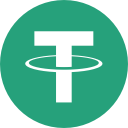Coinbase
How to Buy Tether
Good news! You can buy Tether on Coinbase's centralized exchange. We've included detailed instructions to make it easier for you to buy Tether.
Read more

Tether (USDT) is an Ethereum token that is pegged to the value of a U.S. dollar (also known as a stablecoin). Tether’s issuer claims that USDT is backed by bank reserves and loans which match or exceed the value of USDT in circulation. Important note: at this time, Coinbase only supports USDT on the Ethereum blockchain (ERC-20). Do not send USDT on any other blockchain to Coinbase.
Earn up to $2,000 when you buy $50 in crypto
Sign me up
29K
$184.67B
0.06%
$186.92B
185B USDT
Not enough data
187B USDT
$190.13B
#3
6.17%
$85.83B
12.38%
$779.27B
$3.42T
$1.22
-0.01%
USDT vs markets
↗ 5.6%
USDT vs BTC
↗ 7.51%
USDT vs ETH
↗ 19.39%
Tags
stablecoin
asset-backed-stablecoin
usd-stablecoin
fiat-stablecoin
+1
Network | Address | |
|---|---|---|
Avalanche C-Chain | 0xc7198437980c041c805A1EDcbA50c1Ce5db95118 | |
Ethereum | 0xdAC17F958D2ee523a2206206994597C13D831ec7 | |
Arbitrum | 0xFd086bC7CD5C481DCC9C85ebE478A1C0b69FCbb9 | |
Avalanche C-Chain | 0x9702230A8Ea53601f5cD2dc00fDBc13d4dF4A8c7 |
Time | Price | Change |
|---|---|---|
Today | $1.00 | ↗ 0.04% |
1 Day | $1.00 | ↗ 0.04% |
1 Week | $1.00 | ↗ 0.10% |
1 Month | $1.00 | ↗ 0.01% |
1 Year | $1.00 | ↘ 0.01% |
Tether USDt, or USDT, is a digital token launched in 2014, designed to bridge traditional currencies with blockchain technology. Pegged to the value of one U.S. dollar, USDT is considered a stablecoin, aiming to offer consistency in value. Its issuer claims that each USDT token is backed by reserves consisting of assets like cash equivalents and loans. Operating on multiple blockchains, including Ethereum, Avalanche, and Algorand, Tether USDt facilitates transactions across diverse networks. Note: Coinbase currently supports USDT only on the Ethereum blockchain (ERC-20), so ensure compatibility when using the platform.
Tether USDt functions as a digital token on various blockchain platforms, designed to maintain a stable value equivalent to one U.S. dollar. The issuing company aims to support this peg by allocating reserves to match the amount of USDT in circulation, including cash and other assets. Whenever new USDT tokens are issued, the corresponding amount is reportedly added to Tether's reserves. Through this process, Tether seeks to provide transparency and stability, with the value of USDT remaining aligned with the U.S. dollar for seamless digital transactions.
Earn up to $2,000 when you buy $50 in crypto
Earn free crypto after making your first purchase.
Terms apply. Sum of median estimated savings and rewards earned, per user in 2021 across multiple Coinbase programs (excluding sweepstakes). This amount includes fee waivers from Coinbase One (excluding the subscription cost), rewards from Coinbase Card, and staking rewards.
Trending articles
Popularity in posts
#35
Contributors
1,742
Posts
1,742
% About Tether
0.502%
Hold times
0 days
X (Twitter)
50.29% bullish
Sentiment
4.7 ★
Highlights
1,742 unique individuals are talking about Tether and it is ranked #35 in most mentions and activity from collected posts. In the last 24 hours, across all social media platforms, Tether has an average sentiment score of 4.7 out of 5. Finally, Tether is becoming less newsworthy, with 0 news articles published about Tether.
On Twitter, people are mostly bullish about Tether. There were 53.42% of tweets with bullish sentiment compared to 6.22% of tweets with a bearish sentiment about Tether. 46.58% of tweets were neutral about Tether. These sentiments are based on 22929 tweets.
On Reddit, Tether was mentioned in 196 Reddit posts and there were 452 comments about Tether. On average, there were less upvotes compared to downvotes on Reddit posts and more upvotes compared to downvotes on Reddit comments.
Powered by LunarCrush
Information is provided for informational purposes only and is not investment advice. This is not a recommendation to buy or sell a particular digital asset or to employ a particular investment strategy. Coinbase makes no representation on the accuracy, suitability, or validity of any information provided or for a particular asset.
Certain content has been prepared by third parties not affiliated with Coinbase Inc. or any of its affiliates and Coinbase is not responsible for such content. Coinbase is not liable for any errors or delays in content, or for any actions taken in reliance on any content. Information is provided for informational purposes only and is not investment advice. This is not a recommendation to buy or sell a particular digital asset or to employ a particular investment strategy. Coinbase makes no representation on the accuracy, suitability, or validity of any information provided or for a particular asset. Prices shown are for illustrative purposes only. Actual cryptocurrency prices and associated stats may vary. Data presented may reflect assets traded on Coinbase’s exchange and select other cryptocurrency exchanges.